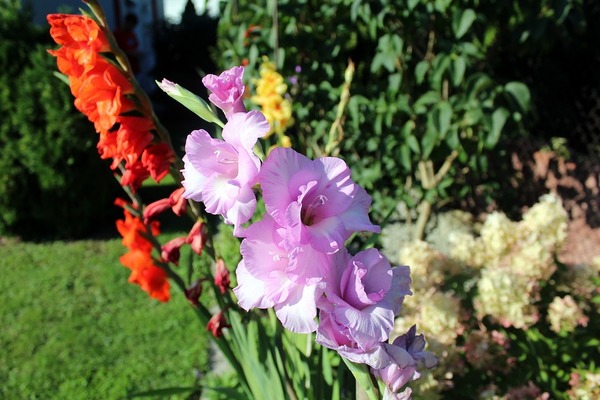The flower for the month of August is Dame Edna’s trademark favourite flower, the Gladiolus.
It is said to symbolise strength, moral integrity, remembrance and infatuation. It is also the flower to celebrate the 40th wedding anniversary.
I personally love gladdies. They are such a beautiful and easy flower to arrange, last so well as a cut flower and look so spectacular.
In another life I had a supply of beautiful pale apricot/pink gladdies from November through to February brought to me from a “secret garden” and I used to regularly fill an old fashioned, large, grey water jug that had belonged to my grandmother with blue gum tips, blue hydrangea, gladdies and white Shasta daisies and have them in the front entrance of our home.
It was not uncommon to receive two or three dozen spikes at a time.
They looked spectacular on the turned wood pedestal that my father had made for me many years before. It is a memory that brings a happy smile at every remembrance.
I plan on having a “picking garden” for gladdies just so I can replicate this where I am now but realise I will never be able to have such a lavish display as I had then.
The range of new colours available each year seems to be ever increasing and a bright lime green is one that has taken my eye in catalogues this year.
About seven species were found naturally in South Africa and from these about 10,000 cultivated varieties are now available.
This means that there is one for every situation.
They come in many heights, colours, size of blooms, with frilly edges or smooth and in bi colours. There is a gladiolus for every garden, bouquet and arrangement.
The name comes from the Latin word for sword from the shape of the leaves and that is where the meaning of infatuation comes – the flower pierces the heart of the person to whom they are given!
The other common names for them is the sword or corn lily and they are a member of the Iris family.
They were first brought to Europe in the 17th century and then in large numbers in the 18th century.
As cut flowers they are very susceptible to fluoride. When purchasing them from the florist or markets, look carefully for bruising and that the first four or five flowers are showing colour.
When you get them home, cut the ends and put them in a hydrating solution so the flowers can rehydrate quickly and then put them in non-fluoridated water with a good flower food.
Fluoride can prevent blooms from opening and cause burning to the edges of petals.
Vase life is said to be about six to 10 days but in my experience it can be much longer depending on type, and state of maturity when they are picked or purchased.
If the fact about fluoride is not enough trivia for today here is more. Gladiolus are geotropic. This means that the stems curve upward in response to gravity!
The other birth flower is the poppy in all its forms and there are many varieties. Different coloured poppies have different meanings. A red poppy signifies pleasure, white is for consolation while yellow wishes the recipient wealth and success.
Iceland poppies are the ones I remember from childhood and although I haven’t grown them for a number of years I still appreciate a bed or border of the brightly coloured four petals on a hairy stem!
I remember picking them and then, to get them to keep in a vase, burning the bottom of the stem.
Some I have growing at present have huge double frilly flower heads, usually pink, with sturdy grey/green stems and leaves. I think they may be a form of Oriental poppy.
Then there is the Californian poppy in shades of cream through yellow to bright orange. They seem to grow very easily and could almost be called a weed if left unattended.
The favourite for November is, of course, the beautiful black centred, bright red, Flanders poppy that is used widely in remembrance services for 11 November.
Probably the most desirable is the clear blue Himalayan poppy. I have not seen it flowering but photos are certainly spectacular.
They are a little like the gladiolus in that there is a poppy for most applications and situations.







